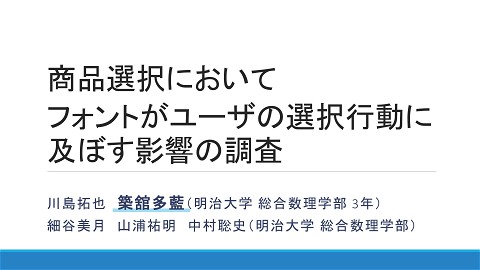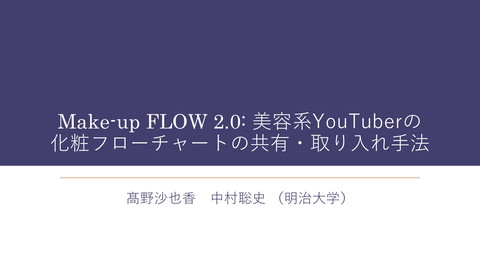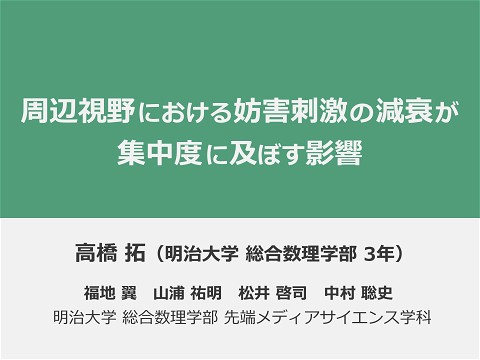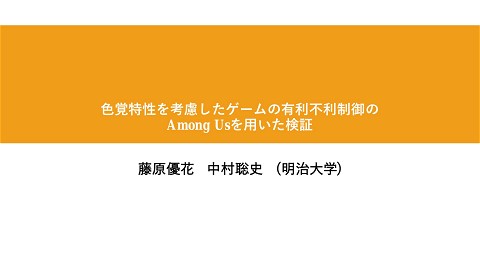Analysis of utilization in the message card production by use of fusion character of handwriting and typeface
381 Views
September 25, 19
スライド概要
INTERACT2019 発表資料(佐々木美香子)
明治大学 総合数理学部 先端メディアサイエンス学科 中村聡史研究室
関連スライド
各ページのテキスト
Analysis of Utilization in the Message Card Production by Use of Fusion Character of Handwriting and Typeface Mikako Sasaki Meiji University Junki Saito, Satoshi Nakamura Meiji University
Culture that Japanese send letters Japanese have many opportunities to write message
Characteristic of message written by hand People can feel the personality and warmth of the writer
Resistance to handwriting But, most Japanese have resistance to handwriting a message themselves. ) 41 4 %. 1 2 240 . 1 , %. ( %0%. 240 1 4 2 2 4 0 . % 4 0 % 1
Previous study [Sasaki ‘18] Implement the system creating a message card by fusing handwriting and typeface
Mathematization of character Y = 229.95cos(0t) + 0sin(0t) + 48.82cos(1t) + -0.23sin(1t) + 4.75cos(2t) + -0.05sin(2t) + 44.24cos(3t) + -0.7sin(3t) + 16.89cos(4t) + -0.36sin(4t) + … X = 272.08cos(0t) + 0sin(0t) +16.62 cos(1t) + -0.09sin(1t) + 29.81cos(2t) + -0.32sin(2t) + -2.91cos(3t) + 0.05sin(3t) + -37.67cos(4t) + 0.8 sin(4t) + … // . /
Previous study [Sasaki ‘18] We conducted the experiment about improving visibility and reducing resistance of the writer by fusing handwriting and typeface. From the experiment, the fusion character is… n Reduce resistance to one’s handwriting n Keep characteristics of handwriting n Favorable impression to the message card using fusion character
Previous study [Sasaki ‘18] We conducted the survey about improving visibility and reducing resistance of the writer by fusing handwriting and typeface. When creating the system, From the experiment, the fusion character is… we wondered if the system changed behavior? n Reduce resistance to one’s handwriting n Keep characteristics of handwriting n Favorable impression to the message card using fusion character
Problems of the previous study Writers could not change the type of typeface and the fusion rate. The n Reduce experiments resistance weretoconducted one’s handwriting only for the situation where a writer and of a handwriting reader are close friends. n Keep characteristics
Purpose of this study We clarify that writers change their usage behavior of the system in response to their relationship with the reader and the card design.
Prototype system
Prototype system
Prototype system
Purpose of the experiment We prove how the writer change the creation behavior in response to the relationship and the difference of the card design.
Experimental procedure n 20 participants (10 males, 10 females) n Create the message cards to younger than a writer, a writer’s close friend and older than a writer n Write “Thank you in advance for this year” in Japanese → The expressions of the sentence end were changed in response to the relationships. Younger Close friend 今年もよろしくね 今年もよろしく Older 今年もよろしく おねがいします
Culture of “Keigo” in Japan In Japan, there is the culture of “Keigo” = “Honorific language” Older than you Using words of respect
Message card used in the experiment Because we assumed that the usage behavior change more by the difference of the card’s design, we divided into 2 groups of 10 people. Same design group Different design group Younger Close friend Older
Usage behavior & Questionnaire n We recorded the usage behavior in this experiment. Crea0on 0me, Ra0o of the core and thickness etc… n A:er each of the message cards was completed, the par5cipants answered a ques5onnaire.
Example of product when completed The same design
Example of product when completed The different design
Result4Type of typeface fused with handwriting The same design 0 02 1 1 1 The different design 0 02 1 1 1 Gothic Mincho
Result4Type of typeface fused with handwriting The same design 0 02 1 1 1 The different design 0 02 1 1 1 Gothic Mincho
Result4Type of typeface fused with handwriting The same design 0 02 1 1 1 The different design 0 02 1 1 1 Gothic Mincho
Result4Type of typeface fused with handwriting The same design 0 02 Gothic Mincho 1 1 1 The ratio selected typeface changed in response to The different design the relationship. 0 02 1 1 1
Rela%on with the same design and the different design The same design 2 1 Gothic Mincho 0 0 The difference was particularly striking for message 0 cards with different design. The different design 2 1 0 0 0
Discussion The reason that the differences was striking The writer was influenced by the characteristics of the characters originally written in the card?
Discussion Questionnaire and User behaviors Results of the questionnaire User behaviors Younger Emphasize on “Fusion ratio” The ratio of the thickness is the highest. Close friend 2 participants answered “Whether the character look funny or not”. The creation time is the shortest. Older Emphasize on “Politeness of handwriting” Number of rewriter is the most number.
Discussion Questionnaire and User behaviors Younger Results of the ques7onnaire User behaviors Emphasize on “Fusion ratio” The ratio of the thickness is the highest. 2 participants answered Close The creation time is the “Whether the character look friend Because writing shortest. funny or not”. the card to younger (children), writersEmphasize might have tried to make it easy to read? on “Politeness Number of rewriter is the Older of handwriting” most number.
Discussion Questionnaire and User behaviors Results of the questionnaire User behaviors Emphasize on “Fusion The ratio of the thickness is Younger Writers wantedratio” to create their cards the forhighest. an older with beautiful 2 participants answered characters, Close The creation time is the “Whether the character look which made them write the message shortest. carefully. friend funny or not”. Older Emphasize on “Politeness of handwriting” Number of rewriter is the most number.
Findings from results in this experiment n Participants changed the type of typeface in response to the card’s design. n Participants changed the usage behavior in response to the relationship.
Findings from results in this experiment n Participants changed the type of typeface in response to the card’s design. n Participants changed the usage behavior in response to the relationship. Recommend “Gothic” Younger Select card’s design for fusion The function of automatic recommendation
Future work ABCDE ABCDE ABCDE We will be able to adopt various typeface when being fused with handwriting
Summary of this study n We analyzed the utilization of the system when there are differences in the relationship and the design. n We clarified that the writers changed the utilization in response to the relationship. n We supposed that the differences of the relationship with the reader appeared the characters when using the design in response to the relationship.





